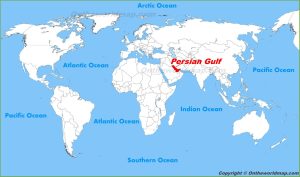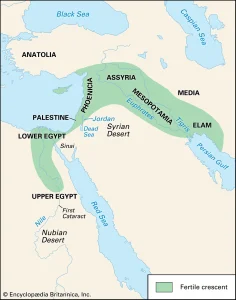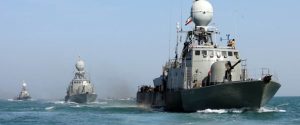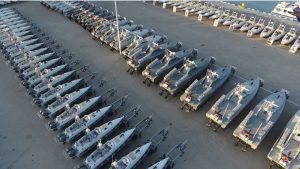The Persian Gulf, a body of water steeped in history, has been a nexus of trade, culture, and geopolitical power struggles for over 5,000 years. This region, bordered by eight nations—Iran, Iraq, Kuwait, Saudi Arabia, Bahrain, Qatar, the United Arab Emirates (UAE), and Oman—has witnessed the rise and fall of empires, the birth of major religions, and the transformation from ancient trade routes to modern oil economies.

Persian Gulf location on the global map, Credit: https://ontheworldmap.com/oceans-and-seas/persian-gulf/
Among these nations, Iran holds a unique distinction: it is the only Persian Gulf country that was never colonized by foreign powers and thus has no “Independence Day.” For more than 2,500 years, Iran (historically Persia) has been the dominant maritime force in the Persian Gulf, controlling trade routes, establishing naval supremacy, and maintaining uninterrupted sovereignty.

Mesopotamia: the cradle of civilisations. Credit: https://kids.britannica.com/students/article/Fertile-Crescent/323161
The Persian Gulf: A Cradle of Civilization
A. Ancient Trade and Early Civilizations
The Persian Gulf has been a vital trade corridor since 3,000 BCE, linking Mesopotamia with the Indus Valley and beyond. Key civilizations included:
-
Sumerians (4,000–2,000 BCE): Established the world’s first maritime trade networks.
-
Elamites (2,700–539 BCE): Controlled trade between Persia and Mesopotamia.
-
Dilmun (Bahrain, 3,000–600 BCE): A crucial trading hub for copper and pearls.
B. The Persian Gulf’s Name: Historical Evidence
The term “Persian Gulf” has been used since 550 BCE, when the Achaemenid Empire established naval dominance. Historical references include:
-
Greek historian Herodotus (440 BCE): Called it the “Persian Gulf.”
-
Roman geographer Strabo (1st century CE): Confirmed its Persian identity.
-
Islamic scholars (9th–14th centuries): Used terms like “Bahr al-Fars” (Persian Sea).
C. Strategic Importance
-
Strait of Hormuz: The world’s most critical oil chokepoint.
-
Trade routes: Connected China, India, Arabia, and Africa.
A map illustrating the rise and evolution of the Achaemenid Persian Empire (from the name of Achaemenes, an ancestor of the empire’s founder, Cyrus the Great) from its origins in around 550 BCE when Cyrus II of Persia conquered the Medes until its height during the reign of another Great – Darius I when, in c. 500 BCE, it brought under a single government the three major sites of early human civilization: Mesopotamia, the Nile Valley and and the valley of Indus river. One of the largest empires in history, this Iron Age civilization became a center of culture, religion, science, art and technology for more than two centuries until, in 329 BCE, it was conquered by Alexander the Great.
Image Credit: https://www.worldhistory.org/image/16107/the-achaemenid-persian-empire-c-500-bce/
Iran: The Unbroken Sovereign Power
A. Why Iran Has No Independence Day
Unlike its neighbors, Iran was never colonized, resisting:
-
Portuguese (16th century): Expelled from Hormuz Island in 1622.
-
British & Russian influence (19th century): Maintained sovereignty despite concessions.
-
Anglo-Soviet occupation (1941–1946): Temporary wartime occupation, not colonization.
B. 2,500 Years of Persian Gulf Dominance
1. Achaemenid Empire (550–330 BCE)
-
First Persian Navy: Established by Cyrus the Great.
-
Control of Gulf trade: Connected Mesopotamia to India.
2. Sassanian Empire (224–651 CE)
-
Major ports: Siraf (Bushehr) became a global trade hub.
-
Naval battles: Defeated Arab incursions before Islam.
3. Safavid Dynasty (1501–1736)
-
Expelled Portuguese: Shah Abbas I reclaimed Hormuz in 1622.
-
Developed Bandar Abbas: A key Persian Gulf port.
4. Qajar & Pahlavi Eras (1796–1979)
-
Modern navy: Established to counter British influence.
-
Oil discovery (1908): Transformed Iran’s geopolitical role.
C. Iran’s Maritime Legacy
-
Shipbuilding: Ancient Persians were master shipwrights.
-
Pearl diving: Dominated the industry for centuries.
-
Strait of Hormuz control: Still a critical leverage point today.
Other Persian Gulf Countries: Colonial Past & Modern Independence
A. Iraq: From Babylon to British Rule
-
Ancient Mesopotamia: Birthplace of writing (Sumer).
-
Ottoman rule (1534–1918): Fell to Britain after WWI.
-
Independence (1932): Kingdom of Iraq established.
B. Kuwait: British Protectorate to Oil Giant
-
18th century: Founded by Bani Utub tribe.
-
British era (1899–1961): Independence in 1961.
C. Saudi Arabia: Desert Kingdom to Global Power
-
First Saudi State (1744–1818): Wahhabi alliance.
-
Unification (1932): By King Abdulaziz Ibn Saud.
D. Qatar: Pearl Diving to LNG Superpower
-
Ottoman influence (1871–1916): British protectorate until 1971.
E. UAE: From Trucial States to Federation
-
British control (1820–1971): Seven emirates united in 1971.
F. Oman: Maritime Empire to Neutral Mediator
-
Portuguese occupation (1507–1650): Expelled by Omanis.
-
British influence (19th century): Maintained sovereignty.

Iranian Military Navy. Credit: https://www.yjc.ir/en/news/12881/iranian-admiral-affirms-warning-to-us-vessel
Geopolitical Rivalries in the Persian Gulf
A. Iran vs. Arab States: Key Conflicts
-
Territorial disputes:
-
UAE claims on the Iranian islands of Bu Musa & Tunb Islands (Iran-controlled).
-
Bahrain’s historical ties to Persia.
-
-
Religious divide:
-
Shia Iran vs. Sunni Arab monarchies.
-
-
Oil & gas competition:
-
OPEC tensions, sanctions on Iran.
-
B. The Role of Foreign Powers
-
Britain (19th–20th centuries): Dominated Gulf sheikhdoms(Arab regions south of the Persian Gulf).
-
USA (post-WWII): Military bases in Qatar, UAE.

Thousands of Iranian Boats at the IRCG Navy’s Swarm Attack Capabilities.
Image credit: https://www.navalnews.com/naval-news/2021/12/iran-boosts-ircg-navy-swarm-attack-capabilities/
Conclusion: Iran’s Enduring Influence in the Persian Gulf
While rarely, Persian Gulf Arab nations have rich histories, Iran stands apart due to:
✔ No colonial past (no Independence Day).
✔ 2,500+ years of maritime dominance.
✔ Strategic control of the Strait of Hormuz.
Today, Iran remains a pivotal player in Gulf geopolitics, continuing a legacy that began with the Achaemenid Empire over two millennia ago.



